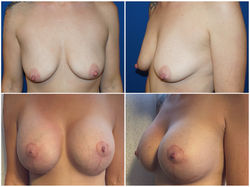Larry A. Sargent, MD FACS
Board Certified Plastic Surgeon
Sargent Plastic Surgery
5.0 (231)
sargent Plastic Surgery


Sargent
Plastic Surgery
Beauty is in the Details

Breast Lift
What Is A Breast Lift?
A breast lift, also known as a mastopexy, is designed to lift, reshape, and firm up a sagging breast. Pregnancy, breastfeeding, weight loss and aging can all have an impact on breasts causing them to lose elasticity and firmness. This result is a breast that has lost its youthful shape. The mastopexy is designed to correct this problem.
Dr. Sargent offers 30+ years of experience in Plastic Surgery to Chattanooga, TN., and has his own in-office operative suite.
Are You A Good Candidate For A Breast Lift?
A breast lift is for women who wish to improve the shape and position of their breasts. You would be a candidate for a breast lift if you have:
-
Sagging or pendulous breasts
-
Lost firmness with skin elasticity
-
Nipple position is too low-below crease of breast
-
Nipple pointing downward or significantly enlarged areola
 |  |  |
|---|---|---|
 |  |  |
 |  |  |
 |  |  |
 |  |  |
 |  |  |
 |  |  |
 |  |  |
 |
All Procedures Shown were done by Larry A. Sargent, M.D. FACS
Do I Need Breast Implants With My Lift?
While the breast lift raises the breast and improves shape it does not increase volume. Loss of volume of your breasts is commonly associated with sagging. You may be a candidate to have implants placed at the time of your breast lift. This can effectively restore volume as well as further enhance breast shape.
What Type Of Lift Do I Need?
Breast lifts are individualized using different incision patterns. This is based on:
-
Breast size and shape
-
Position and size of areola
-
Degree of sagging
-
Amount of excess skin
The most common incisions or patterns used for a breast lift are:
-
Around the areola
-
Around the areola and vertically down from the areola to the breast crease
-
Around the areola, down to the crease, and horizontally in the crease of the breast
The more severe the sagging and the lower nipple positions require more incision to restore a youthful appearance.
Recovery?
After your procedure, you will either be in a bandage or a support bra. Bruising and swelling are to be expected and will resolve in several weeks. Pain medication may be needed the first several days. Your full results won’t be apparent until 4-6 weeks. Heavy exercising and lifting should be avoided for 4-6 weeks.
Quick Answers
Length Of Operation
1 1/2-3 hours
Anesthesia
Usually intravenous sedation or general anesthesia
Length Of Stay
Outpatient procedure
Recovery
After your procedure, you will either be in a bandage or a support bra. Bruising and swelling are to be expected and will resolve in several weeks. Pain medication may be needed the first several days. Your full results won’t be apparent until 4-6 weeks. Heavy exercising and lifting should be avoided for 4-6 weeks.
-
Mild to moderate discomfort the first several days
-
Restrict to minimal activity for several days
-
Moderate bruising and swelling for several weeks
-
Back to work in 7-10 days or less
-
No strenuous exercise for 4-6 weeks
Scars
-
Usually around areola extending down into crease of breast.
-
Maybe smaller depending on type of lift performed.
-
Scars are not seen in clothing or swimwear and fade with time.
Risks / Possible Complications
Serious complications are rare, however possible risks include:
-
Infection
-
Bleeding or Hematoma – collection of blood
-
Skin wound healing
-
Skin loss is extremely rare
-
Changes in nipple sensation, however usually nipple sensation is preserved
-
Does not necessarily have an impact on breast feeding






